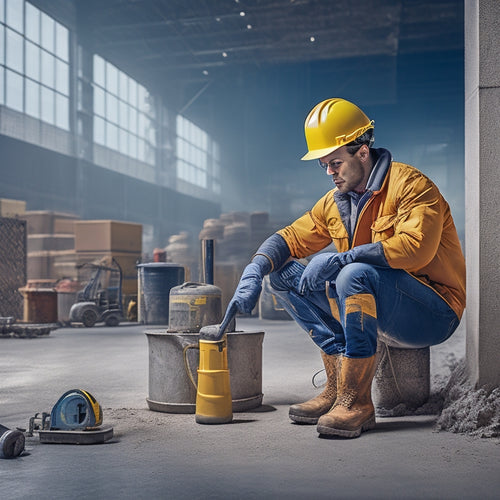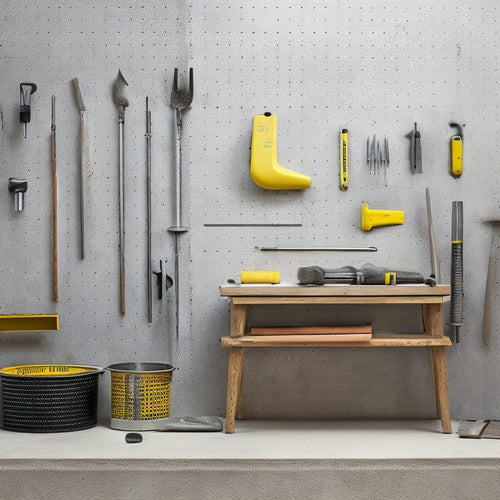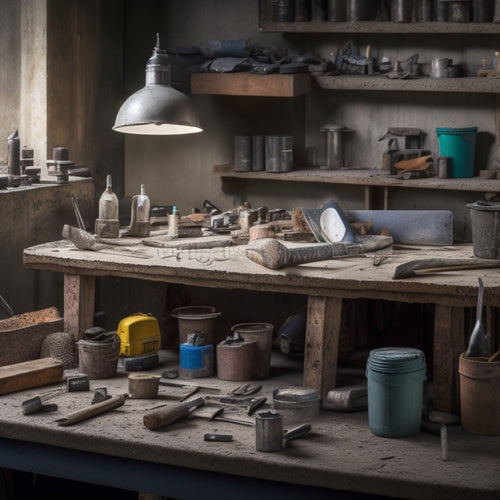
Top Tools for Precise Concrete Block Construction
Share
You'll need a range of specialized tools to guarantee precise concrete block construction, including trowels for efficient block laying, leveling tools like laser levels and grade rods for accurate alignment, and cutting and splitting equipment like masonry saws and block splitters. Mortar mixing and application tools, joint spacing and alignment tools, and pointing and grouting tools are also essential. Additionally, measuring and marking tools like digital calipers and laser distance meters, as well as safety gear like hard hats, protective eye wear, and steel toe boots, are must-haves. Now, explore the specifics of each tool to reveal the secrets of precise concrete block construction.
Key Takeaways
• Essential tools for concrete block construction include trowels, leveling tools, plumb verification tools, cutting and splitting tools, and mortar mixing and application tools.
• Accurate measurement and marking are crucial, and digital calipers, marking gauges, and laser distance meters can help achieve precision.
• Proper joint spacing and alignment are critical for structural integrity and aesthetics, and laser levels and string lines can ensure consistency.
• Safety gear, including hard hats, eye wear, and steel toe boots, is necessary to prevent injuries while working with concrete blocks.
• Mastery of mixing techniques, application techniques, and block handling and placement are critical for project success and structural durability.
Essential Trowels for Block Laying
You'll need a range of specialized trowels to efficiently and accurately lay concrete blocks, as each type is designed to perform specific tasks. There are various trowel types, including pointing trowels, finishing trowels, and edging trowels, each suited for a particular stage of the block-laying process.
Pointing trowels, for instance, are ideal for applying and spreading mortar, while finishing trowels are used to smooth and finish the surface.
Proper trowel maintenance is essential to guarantee peak performance and extend the lifespan of your tools. Regularly clean your trowels to prevent mortar from hardening on the surface. You should also apply a thin layer of lubricant to prevent rust and corrosion.
Additionally, inspect your trowels regularly for signs of wear and tear, and replace them as needed. By having the right trowels for the job and maintaining them properly, you'll be able to achieve professional-looking results and guarantee a strong, durable concrete block structure.
Leveling Tools for Precise Alignment
When you're building with concrete blocks, you need to guarantee that your foundation is level and plumb to prevent structural issues down the line.
To achieve this, you'll rely on leveling tools that help you establish a precise grade and verify accurate plumb lines.
Precise Grade Establishment
With the foundation laid, precise grade establishment becomes the vital next step in concrete block construction, relying on leveling tools that guarantee accurate alignment and a uniform base. To achieve this, you'll need to conduct thorough grade surveying to identify any deviations from the desired grade. This involves taking precise measurements of the site's elevation and checking for any irregularities.
Soil compaction is another significant aspect of grade establishment. You'll need to confirm that the soil is compacted to the required density to prevent settling or shifting of the concrete blocks. This can be achieved using specialized equipment such as plate compactors or rollers.
Here are some essential leveling tools you'll need for precise grade establishment:
| Tool | Function | Benefits |
|---|---|---|
| Leveling Rod | Measures elevation differences | Guarantees accurate grade establishment |
| Laser Level | Projects precise leveling lines | Simplifies grade surveying process |
| Soil Compactor | Compacts soil to required density | Prevents settling or shifting of concrete blocks |
| Grade Rod | Measures and marks desired grade | Facilitates accurate grade establishment |
Accurate Plumb Verification
Accurate plumb verification is vital in concrete block construction, as it guarantees that walls and corners are precisely aligned, thereby maintaining the structural integrity of the building. You can't afford to compromise on this critical step, as even slight deviations can lead to costly rework or, worse, structural failures.
To guarantee precise vertical alignment, you'll need reliable leveling tools. Opt for high-quality digital levels or laser levels that provide accurate readings and are easy to use. These tools will help you verify plumbness quickly and efficiently.
For more precise measurements, consider using plumb bob techniques, which involve suspending a weighted string from a fixed point to determine true vertical. Vertical alignment tools, such as precision Spirit Levels or Optical Levels, are also indispensable for guaranteeing accurate plumb verification.
Block Cutting and Splitting Tools
How efficiently you cut and split concrete blocks can greatly impact the overall quality and speed of your construction project.
When working with different block types, it's crucial to choose the right cutting techniques to guarantee clean cuts and minimal waste. For instance, you'll want to use a masonry saw or a diamond blade saw for straight cuts on standard blocks, while a block splitter or a carbide-tipped handsaw is better suited for curved cuts or splitting blocks into smaller pieces.
When it comes to cutting techniques, you'll need to take into account the type of block you're working with. For example, you may need to use a dry-cutting technique for dense blocks or a wet-cutting technique for softer blocks to minimize dust and prevent overheating.
Additionally, you'll want to verify you're using the right blade or saw for the job, as using the wrong tool can lead to uneven cuts, chipping, or even damage to the block itself.
Mortar Mixing and Application
When you're working with concrete blocks, you know that mortar mixing and application are critical steps in the construction process.
You'll need to maintain precise control over your mixing ratio to guarantee the integrity of the bond between blocks, and then apply the mortar correctly to achieve a strong and durable structure.
Mixing Ratio Control
You must carefully regulate the mixing ratio of cement, sand, and water to produce a workable mortar that meets the project's specifications. This requires a deep understanding of the materials and their interactions, as well as the ability to make precise ratio adjustments.
To achieve the perfect mix, you'll need to master various mixing techniques, such as:
-
Consistent batching: Verify that each batch of mortar is mixed to the same ratio to maintain consistency throughout the project.
-
Ratio adjustments: Be prepared to adjust the ratio of cement to sand to water based on factors like temperature, humidity, and the type of cement being used.
-
Gradual mixing: Add ingredients gradually, allowing each component to fully incorporate before adding the next, to prevent segregation and verify a uniform mix.
Proper Application Techniques
With the mixing ratio under control, attention turns to proper application techniques, where precise mortar mixing and application methods guarantee a strong, durable bond between concrete blocks.
You'll want to focus on block adhesion techniques that guarantee a solid foundation for your structure. Start by preparing the block surface, making sure it's clean, dry, and free of debris.
Next, apply a thin layer of mortar to the block, using a trowel to spread it evenly. Hold the trowel at a 45-degree angle to guarantee the mortar fills the gaps between the blocks.
When applying mortar, use a consistent pressure to avoid air pockets and uneven distribution. Hold the block in place for a few seconds to allow the mortar to set. Use a level to guarantee the block is properly aligned.
For corners and edges, use specialized mortar application methods, such as the 'buttering' technique, to guarantee a strong bond.
Joint Spacing and Alignment
Proper joint spacing and alignment are critical to guaranteeing the structural integrity and aesthetic appeal of concrete block construction projects.
As you work on your project, it's important to pay close attention to these details to achieve professional-looking results. When it comes to joint spacing techniques, you'll want to verify that the spacing is consistent and accurate to prevent cracks and weaknesses in the structure.
Here are three vital alignment tools you should have in your toolkit:
-
Laser levels: These tools project a level line or point, allowing you to verify that your blocks are aligned perfectly.
-
String lines: These simple yet effective tools help you maintain a consistent joint spacing and alignment.
-
Alignment gauges: These gauges provide a precise measurement of joint spacing, verifying that your blocks are spaced correctly.
Block Handling and Placement
When building with concrete blocks, you know that precise handling and placement are vital. Frequently, concrete block construction projects require careful block handling and placement to prevent damage and secure accurate coursing. You can't afford to neglect this step, as it directly impacts the structural integrity and aesthetic appeal of your project.
To guarantee smooth block transportation, you'll need to choose the right block transportation methods. This might include using block carts, dollies, or even forklifts, depending on the size and weight of your blocks.
Once you've transported your blocks to the site, it's important to employ proper block stacking techniques. This involves arranging blocks in a stable, organized manner to prevent damage and make them easier to access.
Pointing and Grouting Tools
You'll need to make certain the blocks are accurately aligned and securely held in place before moving on to the next stage of concrete block construction, where pointing and grouting tools take center stage.
At this phase, you'll focus on filling gaps and joints with mortar, ensuring a strong and durable structure. To achieve professional results, you'll require the right tools for the job.
Here are three essential pointing and grouting tools you should have in your arsenal:
-
Pointing trowels: Used for applying and shaping mortar in joints, these trowels come in various sizes and shapes to suit different pointing techniques.
-
Grouting floats: Designed for spreading and leveling grout, these floats help you achieve a smooth, even finish.
-
Joint rakes: These tools are used to remove excess mortar from joints, creating a clean and uniform appearance.
When selecting pointing and grouting tools, consider the specific grouting methods you'll be using, as well as the type of mortar and grout you're working with.
Spirit Levels and Laser Guides
Accurately establishing and maintaining a level plane is crucial in concrete block construction, as even slight deviations can compromise the structure's integrity. This makes spirit levels and laser guides essential tools for guaranteeing a precise and accurate layout.
You'll need to master spirit level techniques to guarantee your blocks are aligned perfectly. This involves checking the level in multiple directions, taking readings at multiple points, and making adjustments as needed.
Laser guides, on the other hand, provide a higher degree of accuracy, projecting a level line or plane onto your work surface. This allows you to quickly identify any deviations and make adjustments in real-time.
When choosing a laser guide, look for one that offers high laser guide accuracy, typically measured in degrees or fractions of an inch. By combining spirit levels and laser guides, you'll be able to achieve a level of precision that's unmatched in concrete block construction.
Measuring and Marking Tools
Measure and mark concrete blocks with precision using a range of tools, from traditional tape measures and squares to advanced digital calipers and marking gauges. These tools are essential for achieving accurate measurement and marking, guaranteeing that your concrete block construction project meets the required standards.
To guarantee measurement accuracy, you'll need the right tools for the job. Here are three must-haves:
-
Digital calipers: These provide precise measurements with an accuracy of up to 0.01mm, making them ideal for measuring concrete blocks.
-
Marking gauges: These tools allow you to create consistent and accurate markings on the concrete blocks, guaranteeing that your construction is precise and professional.
-
Laser distance meters: These devices measure distances quickly and accurately, saving you time and effort on the job site.
Safety Gear for Block Work
When you're working with concrete blocks, safety gear is essential to prevent injuries.
You'll need to wear the right protective equipment to safeguard yourself from potential hazards on the job site.
From hard hats to steel toe boots, you'll want to guarantee you have the necessary gear to get the job done safely and effectively.
Hard Hat Requirements
You must wear a hard hat that meets the Occupational Safety and Health Administration (OSHA) standards for personal protective equipment (PPE) to secure your safety while working with concrete blocks. This isn't a suggestion, but a requirement to prevent serious head injuries from falling objects, debris, or electrical hazards.
When selecting a hard hat, verify it meets the following hard hat standards:
-
ANSI Z89.1: The American National Standards Institute (ANSI) sets the standard for hard hats, which includes requirements for impact resistance, penetration resistance, and retention system performance.
-
OSHA 29 CFR 1926.100: OSHA regulations dictate that hard hats must be worn on construction sites, and that they must comply with ANSI Z89.1 standards.
-
Manufacturer's guidelines: Follow the manufacturer's instructions for proper use, maintenance, and replacement of hard hats to verify their effectiveness.
Regular helmet maintenance is essential to extend the lifespan of your hard hat. Inspect your hard hat regularly for signs of damage, and replace it immediately if you notice any cracks, dents, or fading.
Protective Eye Wear
As you move on to handling concrete blocks, your eyes become vulnerable to flying debris, dust, and chemical splashes, making it essential to wear protective eye wear that meets rigorous safety standards. You can't afford to compromise on the quality of your eye protection, as even a minor incident can cause permanent damage.
Look for safety glasses or goggles that provide 99.9% UV protection, ensuring your eyes are shielded from harmful ultraviolet rays. Additionally, opt for lenses with an anti-fog coating to prevent vision obstruction in humid or dusty environments.
It's also vital to choose eye wear with a comfortable, snug fit to prevent them from shifting or falling off during work. Consider wraparound styles or goggles with a gasket seal for added protection.
Don't settle for anything less than ANSI Z87.1-certified eye wear, which guarantees compliance with industry standards. By prioritizing your eye safety, you'll be able to focus on the task at hand with confidence and precision.
Steel Toe Boots
Steel toe boots, a crucial component of personal protective equipment, safeguard your feet from crushing injuries and puncture wounds inherent to concrete block construction. As you work with heavy blocks, machinery, and power tools, the risk of foot injuries is ever-present. Steel toe boots provide a critical layer of protection, allowing you to focus on the task at hand.
Here are three key benefits of wearing steel toe boots on the job site:
-
Protection from crushing: Steel toes absorb and distribute the force of heavy objects, preventing compression injuries to your toes and feet.
-
Slip-resistance and traction: Steel toe boots often feature slip-resistant soles, reducing the risk of falls and slips on wet or uneven surfaces.
-
Electrical hazard protection: Many steel toe boots are designed to protect against electrical shock, a vital consideration when working with power tools and machinery.
To guarantee your steel toe boots continue to provide maximum protection, it's important to perform regular boot maintenance. Clean and inspect your boots regularly, and replace them promptly if you notice signs of wear or damage.
Frequently Asked Questions
What Is the Ideal Temperature for Laying Concrete Blocks?
When laying concrete blocks, you'll want to verify the ideal weather conditions for best results.
The ideal temperature for block placement ranges from 50°F to 70°F (10°C to 21°C), with relative humidity below 60%.
Avoid laying blocks in direct sunlight, strong winds, or during extreme weather conditions.
This temperature range allows for proper curing, reducing the risk of cracks and guaranteeing a strong, durable structure.
Can I Reuse Mortar That Has Already Set?
You're wondering if you can reuse mortar that has already set.
Unfortunately, the answer is no. Once mortar has set, its composition changes, making it unsuitable for reapplication.
Reworking techniques can't revive it either. The hardened mortar has formed strong bonds that can't be reversed, and attempting to reuse it will compromise the structural integrity of your concrete blocks.
It's best to mix a fresh batch to guarantee a strong, reliable bond.
How Do I Remove Dried Mortar From My Tools?
You're wondering how to remove dried mortar from your tools.
Start by scraping off excess mortar with a putty knife or wire brush, being careful not to scratch the tool's surface.
Next, soak the tool in warm water and mild detergent for several hours.
For tougher mortar removal, try using a vinegar-based solution or a specialized mortar remover.
Regular tool cleaning methods, like wire brushing and oiling, can also help prevent mortar buildup in the future.
What Is the Recommended Cure Time for Freshly Laid Blocks?
Will you risk compromising the strength of your concrete blocks by skipping the curing process? Don't take the chance!
You'll want to allow freshly laid blocks to cure for at least 24 hours, depending on the curing methods used. Proper curing guarantees block hydration, which is essential for achieving maximum strength.
Keep in mind that temperature, humidity, and the type of cement used can affect the curing time - so be certain to consult the manufacturer's guidelines for specific recommendations.
Can I Use a Hammer to Tap Blocks Into Place?
When it comes to tapping blocks into place, you'll want to use a more precise tool than a hammer. A hammer can cause misalignment and damage to the blocks.
Instead, use a tapping tool or a rubber mallet to gently tap blocks into position, ensuring accurate block alignment.
Master a gentle tapping technique to avoid applying too much force, which can compromise the structural integrity of your construction.
Conclusion
As you've equipped yourself with these top tools for precise concrete block construction, you're now on the cusp of creating structures that will stand the test of time.
But, the real question is, will you be able to wield them with precision and finesse?
Will you be able to overcome the challenges that lie ahead and emerge victorious?
The fate of your project hangs in the balance, and only time will tell if you have what it takes to achieve concrete block perfection.
Related Posts
-

10 Best Tools for Sealed Concrete Flooring on Budget
When starting on a sealed concrete flooring project on a budget, you'll need to prioritize essential tools without sa...
-

10 Must-Have Tools for Concrete Repair Organization
You'll need a solid organization system to keep your concrete repair tools and materials within easy reach, protected...
-

Top Tools for Concrete Repair Success
When it comes to concrete repair success, you'll need a well-stocked toolkit with essential hand tools like trowels, ...


